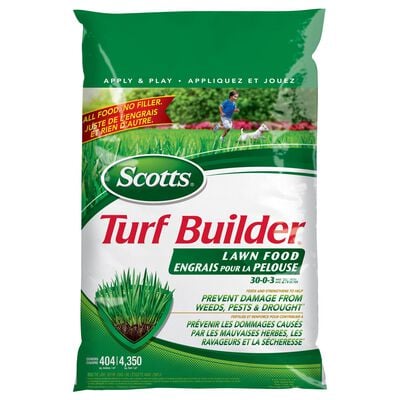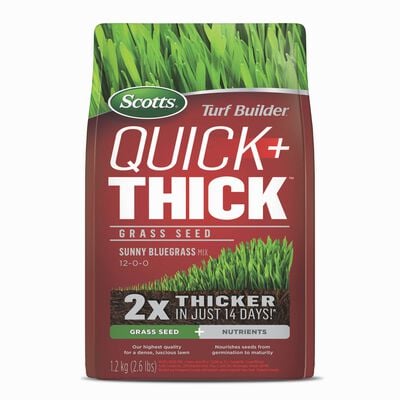Feed In The Fall for a Better Lawn Next Spring
Scotts® Turf Builder® Fall Lawn Food provides the essential nutrients your lawn needs to recover from summer stress—like heat, drought, and heavy use—helping it grow back stronger and greener in the spring.

Scotts® Turf Builder® Fall Lawn Food
Fertilize your lawn in the fall to help build strong, deep grass roots for a thicker, better lawn next spring.

Scotts® Turf Builder® Fall Lawn Food works by feeding your lawn the nutrients it needs to thrive in the fall.
Know Your Fall Lawn
Lower temperatures cause grass blades that might have gone dormant and turned brown over the summer to green up again while roots continue to grow deeper. During the fall, grasses are also working overtime to store sugars in their rhizomes that will help them start growing again the following year.

Feed Your Fall Lawn
In the fall (usually right after around Labour Day), do your first fall feeding. Apply Scotts® Turf Builder® Fall Lawn Food to your lawn with a Scotts Spreader, following label directions.

Maintain a healthy lawn
Scotts® Turf Builder® Fall Lawn Food also helps your lawn recover from the heat and drought stresses of summer and prepares it for winter by storing all the nutrients it needs to survive and so that you have a better lawn next spring.

Fall Is The Best Time To Overseed Your Lawn
Spread Scotts® Turf Builder Quick + Thick™ and see results in just 14 days!*

Scotts® Turf Builder® Quick + Thick™
Grow a green lawn, 2X thicker in just 14 days*. Contains a special time-release formula to nourish seeds from germination to maturity.

Overseeding and Reseeding Your Lawn
Overseeding simply means spreading grass seed over an existing lawn to thicken the turf and fill in bare/thin spots. Over time, seasonal stresses such as heat, drought, winter conditions, and pests can cause your grass to deteriorate. If your lawn is just thin or damaged, overseeding is a fast, inexpensive way to help bring your lawn back to its lush, green, healthy self without tearing everything out and starting over.

When Is the Best Time to Plant Grass Seed?
Grass seed grows best when temperatures are between 15-20 degrees celsius. Early fall is the best time to seed because of its shorter days, cooler nights, and heavier dews. Your most successful seeding time is right around Labour Day. Seeding 2 weeks before or after that easy-to-remember holiday gives your new seedlings time to build strong roots before the winter.

Water Well, and Watch It Grow
Keep the seeded area moist by watering once or twice a day until you see it germinate and grow tall enough to mow. If you planted grass seed around trees, the trees are hungry and thirsty, and will compete with grass for available water and nutrients. Be sure to regularly feed the grass around trees, and be a bit more generous when watering.

*vs Scotts® Turf Builder® Grass Seed 3-1-0 when both are applied at the bare soil rate, when used as directed and subject to proper care.

The Scotts Miracle-Gro No-Quibble Money Back Guarantee™
We stand by our products, which is why we guarantee our customers' satisfaction.















